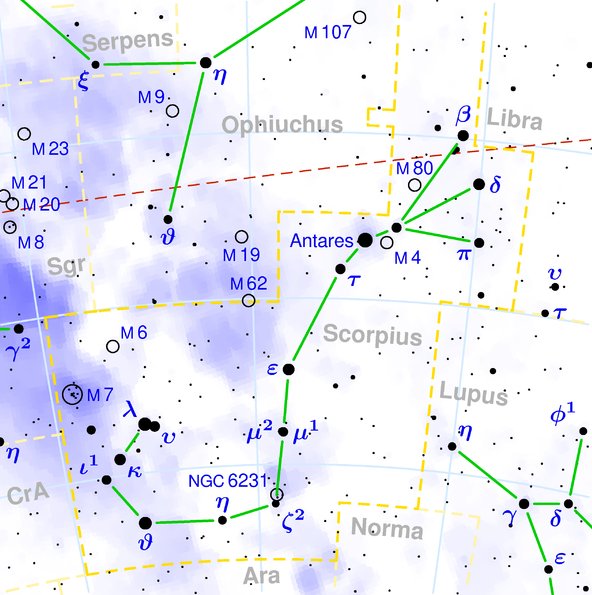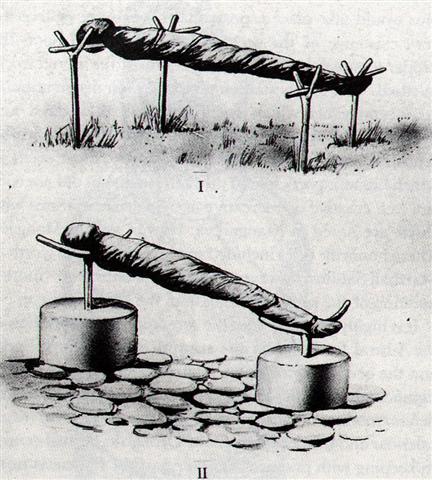TAHUA
5. Metoro saw a new beginning with the pair of Niu
glyphs, this we can infer from his use of a Capital (Head) letter:

|
 |
*14 |
 |
*3 |
 |
 |
|
Cb1-15 (407) |
*56 (Alcyone) |
Cb2-8 (32) |
Cb2-9 (425) |
|
e niu tu |
koia ra |
Niu |
Niu at Cb1-15 (→ 115 → Mercury,
Hiro) was
evidently at the pair Zuben
Elgenubi / Bharani.
|
POLYNESIAN NAMES FOR THE PLANET MERCURY |
|
Hawaiian Islands |
Society Islands |
Tuamotus |
New Zealand |
Pukapuka |
|
Ukali
or Ukali-alii 'Following-the-chief'
(i.e. the Sun)
Kawela
'Radiant' |
Ta'ero
or Ta'ero-arii 'Royal-inebriate'
(referring to the eccentric and undignified
behavior of the planet as it zigzags from
one side of the Sun to the other) |
Fatu-ngarue
'Weave-to-and-fro'
Fatu-nga-rue
'Lord of the Earthquake' |
Whiro
'Steals-off-and-hides'; also the universal
name for the 'dark of the Moon' or the first
day of the lunar month; also the deity of
sneak thieves and rascals. |
Te Mata-pili-loa-ki-te-la
'Star-very-close-to-the-Sun' |
And the pair of Niu was evidently
there because of the pair Vrischika / Schedir:
|
 |
*14 |
 |
*3 |
 |
 |
|
Cb1-15 (407) |
Cb2-5 (421, 29) |
Cb2-8 (32) |
Cb2-9 (425) |
|
Oct 31 (304) |
Nov 14 (318) |
Nov 17 (321) |
Nov 18 (322) |
|
ZUBEN ELGENUBI (*224) |
COR
SERPENTIS (*238) |
VRISCHIKA (*241) |
SCHEDIR |
|
BHARANI (*41) |
TAU-ONO
(*55) |
ZAURAK
(*58.9) |
ν Tauri
(*59.9) |
|
May 1 (121) |
May
15 (135 = 500 - 365) |
May 18 (138) |
May 19
(322 - 183) |
Vrischika (π Scorpii)
was 8 right ascension days before Antares (*249):

And the Breast of Queen Cassiopeia
- Schedir - rose heliacally at *8:
... OgotemmÍli had his own ideas about
calculation. The Dogon in fact did use the decimal system,
because from the beginning they had counted on their fingers,
but the basis of their
reckoning had been the number eight and this number recurred
in what they called in French la centaine, which for them
meant eighty. Eighty was the limit of reckoning, after which a
new series began. Nowadays there could be ten such series, so
that the European 1,000 corresponded to the Dogon 800. But
OgotemmÍli believed that in the beginning men counted by eights
- the number of cowries on each hand, that they had used their
ten fingers to arrive at eighty, but that the number eight
appeared again in order to produce 640 (8 x 10 x 8). 'Six
hundred and forty', he said, 'is the end of the reckoning.'
| |
365 days |
| |
(80 + RA / 24h * 365ľ) |
|
Day of culmination |
|
|
Atlas |
May 16 (136, *56) |
*229 |
Dec 31 (365,
*285) |
135 |
|
Alkes |
Sept 3 (246) |
*229 |
April 20 (110) |
135 |
|
Denebola |
Sept 15 (258) |
*230 |
May 3 (123) |
134 |
|
Gienah |
Sept 22 (265,
*185) |
*230 |
May 10 (130, *50) |
134 |
|
ACRUX |
Sept 24 (267,
*187) |
*231 |
May 13 (133. *53) |
133 |
|
JULY 22
(*123 = *187 - *64) |
*231 |
MARCH 10
(*354
→
'290 + *64) |
| |
|
Thuban |
Oct 19 (292,
*212) |
*230 |
June 7 (158, *78) |
134 |
|
Arcturus |
Oct 22 (295,
*215) |
*227 |
June 8 (159, *79) |
*136 |
|
Zuben
Elgenubi |
Oct 31
(304, *224) |
|
June 17 (168, *454.
*88) |
*136 |
 |
|
Vega |
Dec 27 (361,
*281) |
*227 |
Aug 12 (224, *144) |
*137 |
|
Alphekka Meridiana |
Jan 5 (*290) |
*220 |
Aug 13 (225, *145) |
'146 |
|
Deneb Cygni |
Febr 7 (38, *323) |
*221 |
Sept 16 (259,
*179) |
*144 |
|
Fomalhaut |
March 3 (62, *348) |
*236 |
Oct 25 (*584, *218) |
|
| |
|
Schedir |
March 29 (88, *8) |
*233 |
Nov 18 (322, *242) |
131 |
|
Alrisha |
April 19 (109, *212 -
*183 = *29) |
*232 |
Dec 7 (341,
*261) |
132 |
| Menkar |
May
4 (124, *44) |
*231 |
Dec 21 (355,
*275) |
133 |
|
*364 - *229
→ 135 etc. And *144 (August 12) = *281 (December
27) - *137, etc. |
The Scorpion surely implied death (Ü)
and the Breast was necessary at the time of birth (*) - a
complementary contrasting pair which everyone could easily understand.
... The
correspondence
between the
winter
solstice and
the
kali'i
rite of the
Makahiki
is arrived
at as
follows:
ideally, the
second
ceremony of
'breaking
the
coconut',
when the
priests
assemble at
the temple
to spot the
rising of
the
Pleiades,
coincides
with the
full moon (Hua
tapu)
of the
twelfth
lunar month
(Welehu). In
the latter
eighteenth
century, the
Pleiades
appear at
sunset on
18
November.
Ten days
later (28
November),
the Lono
effigy sets
off on its
circuit,
which lasts
twenty-three
days, thus
bringing the
god back for
the
climactic
battle with
the king on
21 December,
the solstice
(= Hawaiian
16
Makali'i). The
correspondence
is 'ideal'
and only
rarely
achieved,
since it
depends on
the
coincidence
of the full
moon and the
crepuscular
rising of
the Pleiades
....
Thus in time-space the distance from Polaris (*26) to the Tail
(Deneb) of the 'Crab' (μ Scorpii)
was 151 (May 31) - 80 (March 21) = 71 right ascension days
→ 355 / 5 = 71 (→
26000 / 366):
 |
 |
 |
 |
 |
|
Cb2-17 |
Cb2-18 |
Cb2-19 (435) |
Cb2-20 |
Cb2-21 (392 + 45) |
| manu rere - toga |
manu |
toga |
ka tuu te toga o
te manu |
kua tapu - no te
manu |
|
Nov 26 |
27 |
28 (332) |
29 |
30 (1334
- 1000) |
|
*250 |
*251 |
*252 |
ATRIA |
DENEBAKRAB |
|
- |
ALDEBARAN |
- |
- |
- |
|
May 27 |
28 (*68 = *251 -
*183) |
29 |
30 (150 = 333 -
183) |
31 (*71) |
|
Tapu. Holy, sacred, forbidden, taboo,
off-limits; to declare holy, forbidden, taboo,
off-limits. he-tapu te pera, to declare a
burial ground taboo. Taputapu, to pace up and
down. Vanaga. To forbid, to prohibit, sacred, holy.
Hakatapu, to forbid, to prohibit, to make
holy, to consecrate. P Pau.: tapu, to swear;
fakatapu, to give sanction to. Mgv., Mq.,
Ta.: tapu, sacred, holy, forbidden,
prohibited. Tapua, holy. Churchill. |
The number of glyphs on the A tablet is 670 + 664 = 1334 and
this could have been constructed as a design in order to point
at November 30 - and implicitly to the ideal measure for the
great (and tapu) precessional cycle of 26000 years.
And the words of Metoro underlines that this dark region was down in the
southwest (toga) - the end station so to say - from where
in November
28
the Lono
effigy
ideally should set off on its circuit.
The living eyes had been removed in Cb2-17--18.
| Toga
1. Winter season. Two seasons used to be distinguished
in ancient times: hora, summer, and toga,
winter. 2. To lean against somehing; to hold something
fast; support, post supporting the roof. 3. To throw
something with a sudden movement. 4. To feed oneself, to
eat enough; e-toga koe ana oho ki te aga, eat
well first when you go to work. Vanaga.
1. Winter. P Pau., Mgv.: toga, south. Mq.:
tuatoka, east wind. Ta.: toa, south. 2.
Column, prop; togatoga, prop, stay. Togariki,
northeast wind. Churchill.
Wooden platform for a dead chief: ka tuu i te toga
(Bb8-42), when the wooden platform has been erected.
Barthel 2.
The expressions Tonga, Kona, Toa
(Sam., Haw., Tah.), to indicate the quarter of an island
or of the wind, between the south and west, and
Tokelau, Toerau, Koolau (Sam., Haw.,
Tah.), to indicate the opposite directions from north to
east - expressions universal throughout Polynesia, and
but little modified by subsequent local circumstances -
point strongly to a former habitat in lands where the
regular monsoons prevailed. Etymologically 'Tonga',
'Kona', contracted from 'To-anga' or 'Ko-ana',
signifies 'the setting', seil. of the sun. 'Toke-lau',
of which the other forms are merely dialectical
variations, signifies 'the cold, chilly sea'. Fornander. |

|









